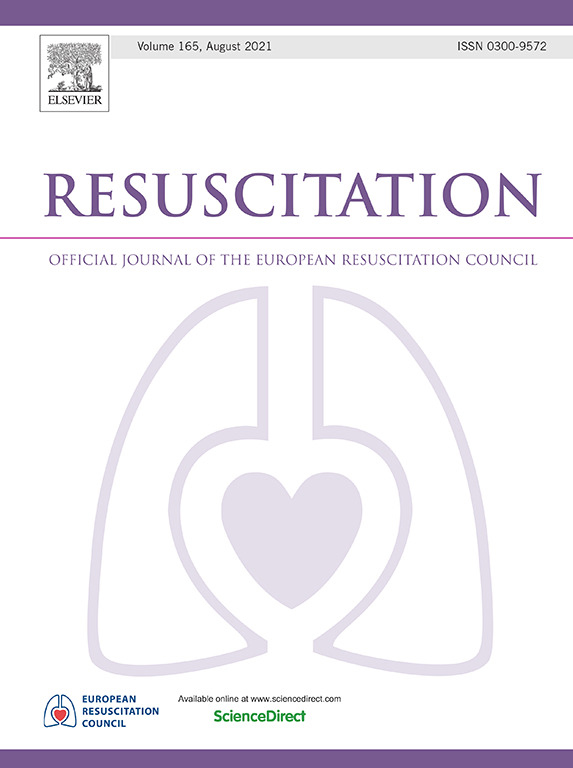Vital signs preceding in-hospital cardiac arrest: a matched case-control study
IF 4.6
1区 医学
Q1 CRITICAL CARE MEDICINE
引用次数: 0
Abstract
Background
Hospitalised patients undergo routine vital sign measurements to detect clinical deterioration. Research into vital signs prior to in-hospital cardiac arrest is crucial, as early detection of deterioration can enable timely intervention and potentially prevent cardiac arrest. This study aimed to investigate the association between vital signs and the risk of in-hospital cardiac arrest.
Methods
We conducted a registry-based, matched case-control study, including cases with in-hospital cardiac arrest and hospitalised patients as controls, in the Central Denmark Region from 2017 to 2022. Exposures were values of heart rate, systolic and diastolic blood pressure, body temperature, respiratory rate, level of consciousness, SpO2, pulse pressure, SpO2/FiO2 ratio, and National Early Warning Score (NEWS) 2. Conditional logistic regression was used to assess the association between continuous and categorical values of vital sign measurements and the risk of in-hospital cardiac arrest.
Results
The study population consisted of 1587 cases and 10,276 controls. The risk of in-hospital cardiac arrest increased incrementally for increasing heart rate, body temperature, respiratory rate, and NEWS 2 score, and decreasing systolic and diastolic blood pressure, body temperature, SpO2, pulse pressure, and SpO2/FiO2 ratio. Associations were most pronounced for systolic blood pressure ≤80 mmHg (OR 15.3 [95 % CI: 9.44–24.7]), SpO2/FiO2 ≤ 2.50 (OR 14.1 [95 % CI: 10.3–19.2]), and NEWS 2 score ≥7 points (OR 11.7 [95 % CI: 9.57–14.3]) compared to normal reference values.
Conclusion
The risk of in-hospital cardiac arrest increases incrementally with the degree of vital sign abnormality.
住院心脏骤停前的生命体征:一项匹配的病例对照研究
背景:住院患者接受常规生命体征测量以检测临床恶化。在医院心脏骤停之前对生命体征进行研究至关重要,因为早期发现病情恶化可以及时干预,并有可能预防心脏骤停。本研究旨在探讨生命体征与院内心脏骤停风险之间的关系。方法:我们在2017-2022年丹麦中部地区进行了一项基于登记的匹配病例对照研究,包括住院心脏骤停病例和住院患者作为对照。暴露值包括心率、收缩压和舒张压、体温、呼吸频率、意识水平、SpO2、脉压、SpO2/FiO2比值和国家预警评分(NEWS) 2。使用条件逻辑回归来评估生命体征测量值的连续值和分类值与院内心脏骤停风险之间的关联。结果:研究人群包括1587例病例和10276例对照。随着心率、体温、呼吸频率和NEWS 2评分的升高,收缩压和舒张压、体温、SpO2、脉压和SpO2/FiO2比值的降低,院内心脏骤停的风险逐渐增加。与正常参考值相比,收缩压≤80 mmHg (OR 15.3 [95% CI: 9.44 - 24.7])、SpO2/FiO2≤2.50 (OR 14.1 [95% CI: 10.3 - 19.2])和NEWS 2评分≥7分(OR 11.7 [95% CI: 9.57 - 14.3])的相关性最为显著。结论:院内心脏骤停的发生风险随着生命体征异常程度的增加而增加。
本文章由计算机程序翻译,如有差异,请以英文原文为准。
求助全文
约1分钟内获得全文
求助全文
来源期刊

Resuscitation
医学-急救医学
CiteScore
12.00
自引率
18.50%
发文量
556
审稿时长
21 days
期刊介绍:
Resuscitation is a monthly international and interdisciplinary medical journal. The papers published deal with the aetiology, pathophysiology and prevention of cardiac arrest, resuscitation training, clinical resuscitation, and experimental resuscitation research, although papers relating to animal studies will be published only if they are of exceptional interest and related directly to clinical cardiopulmonary resuscitation. Papers relating to trauma are published occasionally but the majority of these concern traumatic cardiac arrest.
 求助内容:
求助内容: 应助结果提醒方式:
应助结果提醒方式:


